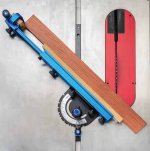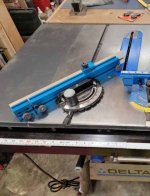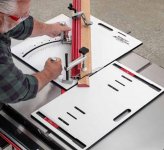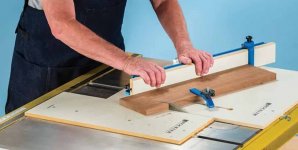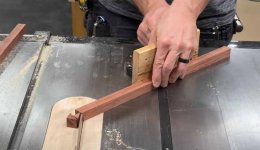smorgasbord
Member
Assuming you use your miter gauge/sliding table/cross-cut sled on the left of the blade (like on a CSC SYS), which way do your rotate the head for angled cuts, and why?
I most often see a clockwise rotate, so the blade contacts the trailing end of the workpiece, like so:
[attachimg=1]
But, I've heard/read that some people prefer to rotate counter-clockwise so that the leading edge of the workpiece contacts the blade first. One rationale is that this way the cutting action is trying to push the blade into the fence stop so it's not totally up to your hands to stop workpiece sliding during the cut. However, this is apparently not very popular as I had trouble finding images demonstrating it:
[attachimg=2][attachimg=3]
I suspect the main reason for this is that the "normal" clockwise rotation optimizes table support for the stock at the beginning of the cut. That is the rotation moves the stock at the left onto the table before the cut starts, so it feels better. And since many woodworkers have built outfeed table supports, the stock is still supported pretty well after the cut, too.
This guy, however, likes to run his miter gauge backwards even at 90º cuts to optimize stock support (short video):
Miter Gauge Backwards Video
There are even some tablesaw sleds made for cutting angles (Rockler, Woodpeckers, etc.), and they all rotate the stock clockwise:
[attachimg=4]
[attachimg=5]
Now, there are picture frame sleds, and they typically run the stock the other way, perhaps because the frame sides can be long and it'd be weird having them so far in front? Or maybe because they're compensating for not being able to cut an accurate 45º angle by doing the both sides of a right angle thing:
[attachimg=6]
Note that this requires a shorter back fence (nearer the operator) so that the stock doesn't hit it. But, on the Woodpeckers/Rockler angle sleds, there is no back fence so they could have just as easily set up the pivot the other way.
I'm redoing my angle cross-cut sled yet again (this will be the third iteration). My two prior versions all rotate the "normal" way, but as I was laying out my design, I realized I could add a pivot point at the top right to accommodate rotating stock counter-clockwise. Is this something worth doing - to have the option? Or am I just complicating things unnecessarily?
I most often see a clockwise rotate, so the blade contacts the trailing end of the workpiece, like so:
[attachimg=1]
But, I've heard/read that some people prefer to rotate counter-clockwise so that the leading edge of the workpiece contacts the blade first. One rationale is that this way the cutting action is trying to push the blade into the fence stop so it's not totally up to your hands to stop workpiece sliding during the cut. However, this is apparently not very popular as I had trouble finding images demonstrating it:
[attachimg=2][attachimg=3]
I suspect the main reason for this is that the "normal" clockwise rotation optimizes table support for the stock at the beginning of the cut. That is the rotation moves the stock at the left onto the table before the cut starts, so it feels better. And since many woodworkers have built outfeed table supports, the stock is still supported pretty well after the cut, too.
This guy, however, likes to run his miter gauge backwards even at 90º cuts to optimize stock support (short video):
Miter Gauge Backwards Video
There are even some tablesaw sleds made for cutting angles (Rockler, Woodpeckers, etc.), and they all rotate the stock clockwise:
[attachimg=4]
[attachimg=5]
Now, there are picture frame sleds, and they typically run the stock the other way, perhaps because the frame sides can be long and it'd be weird having them so far in front? Or maybe because they're compensating for not being able to cut an accurate 45º angle by doing the both sides of a right angle thing:
[attachimg=6]
Note that this requires a shorter back fence (nearer the operator) so that the stock doesn't hit it. But, on the Woodpeckers/Rockler angle sleds, there is no back fence so they could have just as easily set up the pivot the other way.
I'm redoing my angle cross-cut sled yet again (this will be the third iteration). My two prior versions all rotate the "normal" way, but as I was laying out my design, I realized I could add a pivot point at the top right to accommodate rotating stock counter-clockwise. Is this something worth doing - to have the option? Or am I just complicating things unnecessarily?

